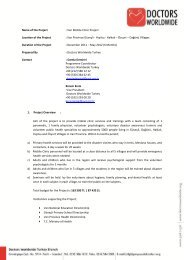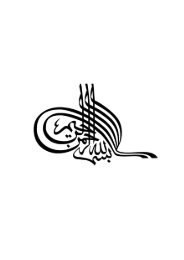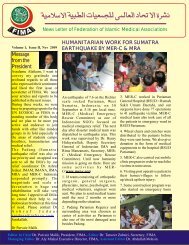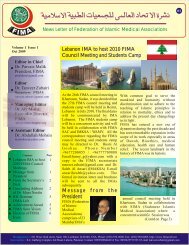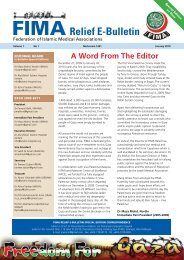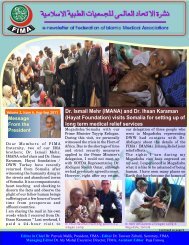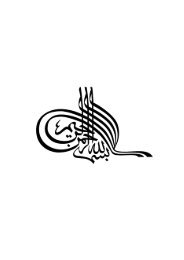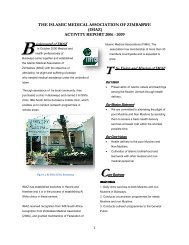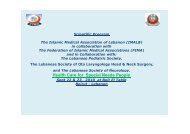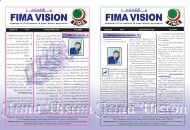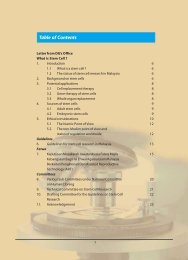FIMA Year Book 2009 - Federation of Islamic Medical Associations
FIMA Year Book 2009 - Federation of Islamic Medical Associations
FIMA Year Book 2009 - Federation of Islamic Medical Associations
Create successful ePaper yourself
Turn your PDF publications into a flip-book with our unique Google optimized e-Paper software.
Muslim Contributionsdevoted to the mentally ill.Najib ul- Din Muhammad, acontemporary <strong>of</strong> al- Razi, left manyexcellent descriptions <strong>of</strong> variousmental diseases. His carefully compiledobservation on actual patients madeup the most complete classification <strong>of</strong>mental diseases theret<strong>of</strong>ore known.Najib described agitated depression,obsessional types <strong>of</strong> neurosis, NafkhaeMalikholia (combined priapism andsexual impotence), Kutrib (a form <strong>of</strong>persecutory psychosis) and Dual-Kulb(a form <strong>of</strong> mania).An asylum for the mentally ill wasbuilt early in the 8th century at Fez,Morocco. This was followed by others;in Baghdad (705 C.E.), in Cairo(800CE), in Damascus and Aleppo(1270C.E.). In addition to baths,drugs, kind and benevolent treatmentgiven to the mentally ill, music-therapyand occupational therapy were alsoemployed. These therapies were highlydeveloped at that time.Unfortunately the great <strong>Islamic</strong>civilization constructed by the Muslimsin that era went into decline after1000 years <strong>of</strong> glory and progress (10) .The flow <strong>of</strong> technology, research anddevelopment from the <strong>Islamic</strong> worldto the West gradually slowed down andultimately completely reversed in thepast 500 years (11) .Over the last decades, Westerneducators have been trying toimprovise the medical educationsystem by emulating the Muslimsystem <strong>of</strong> the past but at the same timeavoiding mentioning that <strong>Islamic</strong> andArab systems pre dated their efforts.A case in point is the introduction <strong>of</strong>an integrated and spiral curriculuminstead <strong>of</strong> dividing curriculum intobasic and clinical sciences based ondisciplines.The best way to inculcate <strong>Islamic</strong> inputin our medical education system is torediscover and revive the methodologyadopted by the great Muslim scholarscited above.The rise and decline <strong>of</strong> Muslims’contribution: why and how?The enormous contributions <strong>of</strong> theMuslims to science in general andmedicine in particular are hardlysurprising. Islam has always extolledits followers to explore the frontiers <strong>of</strong>knowledge beginning with the very firstwords revealed by Jibrail to ProphetMuhammad (PBUH) “ Read” (12) . Thisis followed by many other verses whichchallenge the human mind to look andstudy Allah’s creation (13-16). In at leasttwo such verses, Allah challenged thebelievers to look around themselves andthen at themselves, a clear challengefor humans to understand themselvesbetter (17, 18) . The Qur’an also remindedthe believers that whatever they knowat the time <strong>of</strong> revelation was but a dropfrom an ocean <strong>of</strong> knowledge that iswith the Creator (19) . It was such versesfrom the Qur’an which spurred thethought processes <strong>of</strong> those generationsand which led to inquisitive mindsexploring the frontiers <strong>of</strong> knowledgeculminating in boundless discoveries<strong>FIMA</strong> <strong>Year</strong><strong>Book</strong> <strong>2009</strong>107




